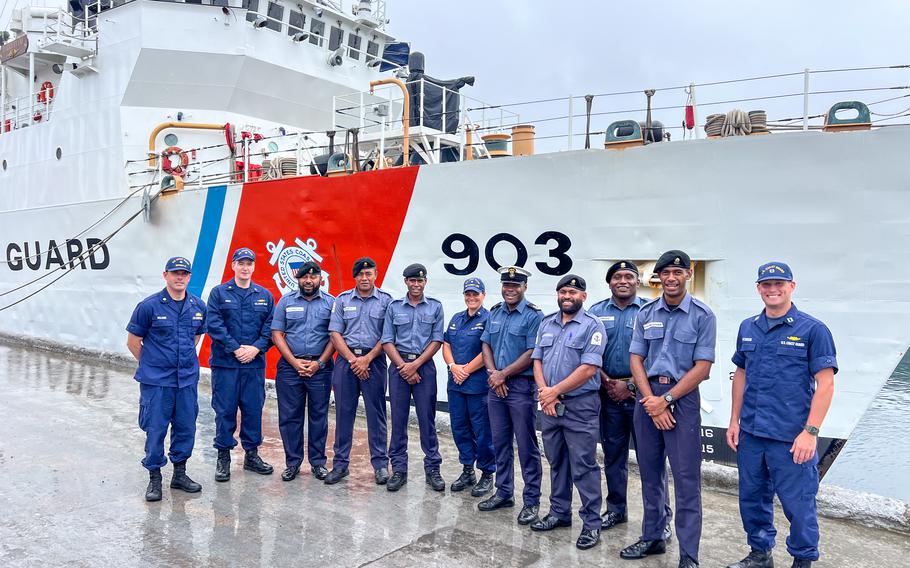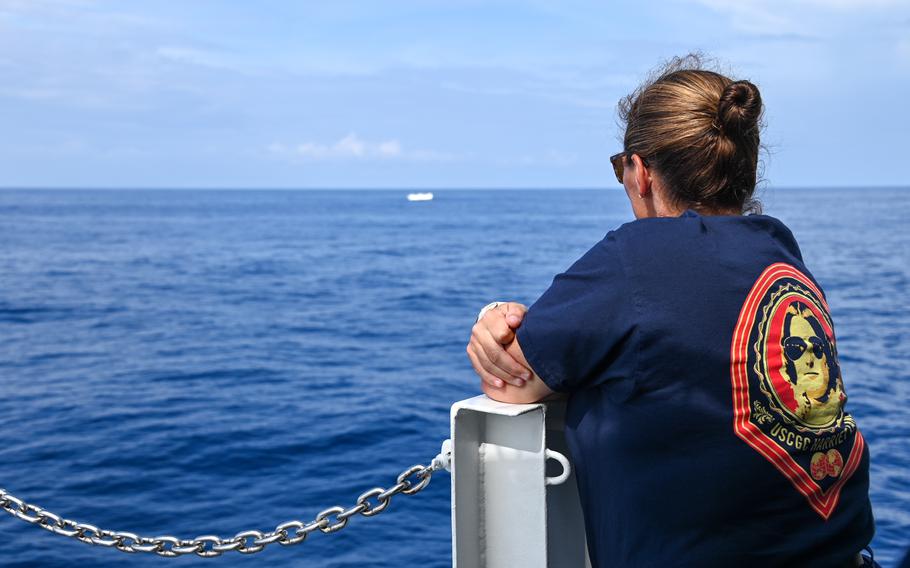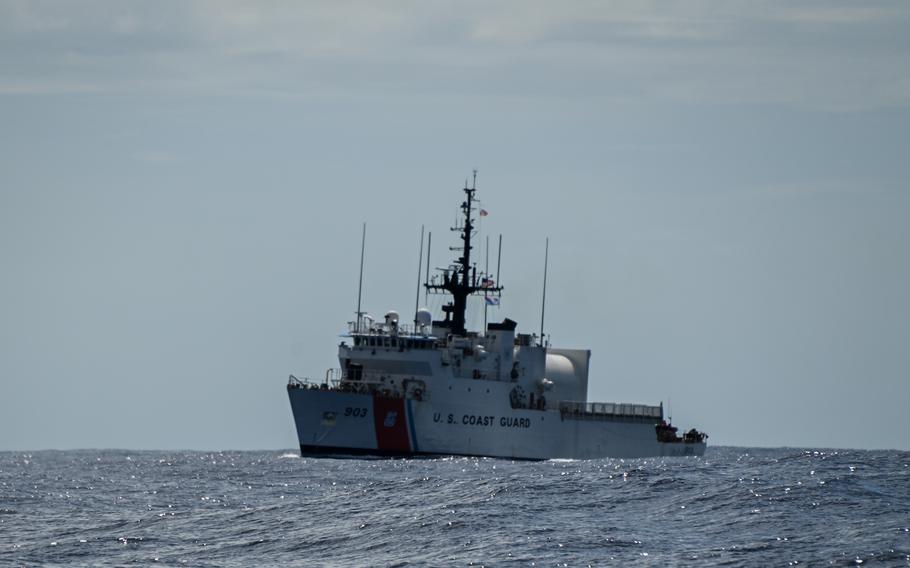
U.S. Coast Guard and Fiji Navy personnel stand in front of the U.S. Coast Guard Cutter Harriet Lane while moored in Suva, Fiji, Feb. 19, 2024. (Charly Tautfest/U.S. Coast Guard)
ABOARD THE CUTTER HARRIET LANE (Tribune News Service) — It was a hot, humid and cloudy day in the South Pacific as the U.S. Coast Guard’s Cutter Harriet Lane pulled into port in Apia, Samoa, earlier this month.
It was the second stop for the 270-foot Medium Endurance Cutter — known as “270s“ — in its new role as the Coast Guard’s “Indo-Pacific Support Cutter“ devoted to operations in Oceania.
The nearly 40-year-old ship arrived in Hawaii in December after undergoing over a year’s worth of renovations at a Baltimore shipyard. In January it set sail for its first Pacific deployment, heading south into the high seas where members of its crew boarded fishing vessels to look for signs of illegal fishing.
It had made a quick stop in American Samoa before heading west into Samoan waters, where Lane’s crew picked up and worked with Samoan law enforcement officials aboard as “ship riders“ for several days, allowing the Samoans to use Lane’s resources and its crew to board fishing vessels within their own jurisdiction through an agreement with the U.S. government.
In Apia, the Lane was supposed to drop off the Samoan ship riders, resupply and send members of its crew shore-side for a series of community service projects and outreach with other Samoan officials.
But as the ship moored at the pier, powerful swells and surf in the harbor raised alarm bells for officers and crew aboard. A storm system was passing through and it could be felt in the seas. The ropes tying the ship to the pier let out audible sounds of strain as the water churned.
Nearby in the port a capsized Chinese fishing vessel offered a vivid visual of what could happen to those who gamble on the ocean’s power.

U.S. Coast Guard Cmdr. Nicole Tesoniero, U.S. Coast Guard Cutter Harriet Lane commanding officer, watches a fishery boarding take place with U.S. Coast Guard members and Fijian shipriders from the Republic Fiji Navy, Ministry of Fisheries, Fiji Immigration, and Fiji Revenue and Customs Services in the Fiji Exclusive Economic Zone in the South Pacific Ocean, Feb. 15, 2024. (Charly Tautfest/U.S. Coast Guard)
Cmdr. Nicole Tesoniero, Lane’s captain, ultimately decided the risk was too high to stay in the port.
The ship riders got off and the Lane’s cooks and other crews hastily brought on food supplies from the pier to restock the kitchen. Then Tesoniero met with officials with the U.S embassy and explained the potential danger — while making new plans on the fly. Lane left as the strain on the ropes reached its peak.
The ship returned to the sea, but stayed nearby. The next day, a handful of crew members left the Lane aboard an “over the horizon“ boat — a small inflatable boat the ship uses for interdictions and boardings — to return to Apia for a day of classroom exercises with Samoan law enforcement. That night, Lane set sail bound for Suva, Fiji, for a port call there to wait out the stormy weather before picking up Fijian ship riders and resuming operations.
Tesoniero said that it’s all part of a process of trial and error as the Lane and its crew undertake a mission they never have before. The Lane and the rest of the Coast Guard’s 270s have a long history in the Caribbean and Latin America doing Drug War missions for which they were designed, along with search-and-rescue operations. There’s a wealth of knowledge and experience to draw on whenever a challenge comes along.
But Tesoniero said that in the Pacific “we’re now at the point of everything we do, we’re the first 270 to ever do it. It’s the first 270 to ever cross the international dateline at 40 years old.”
As the Lane traverses the Pacific, Coast Guard Commandant Adm. Linda Fagan is also making a series of visits to Pacific Island countries, meeting top officials. The Coast Guard is playing an increasingly key role in America’s Pacific strategy as the U.S. competes with China for influence.
‘Sustained presence’
Tesoniero runs the ship with both a sense of authority and a sense of humor, walking a fine line between being both a commander and shipmate as she leads a relatively small crew. A fully staffed 270 would have a crew of just over 100, but low recruitment and retention mean Lane relies on a revolving door of crew members and Coasties on temporary duty assignments to keep it running.
Over the course of her military career, Tesoniero has navigated both storms at sea on ships as well as the nuances of the halls of political power. She both taught at the Coast Guard Academy and did a stint on the staff of former Chairman of the Joint Chiefs of Staff Gen. Mark Milley at the Pentagon.
Now it’s her job to lead Lane and its crew on a mission that top officials in Washington hope will breathe new life into America’s Pacific engagement strategy. The Coast Guard has been working to increase its Pacific operations, with a major focus on outreach to Pacific Island nations as well as efforts to clamp down on illegal fishing.
Overfishing has become a hot topic, particularly in Oceania, where fishing vessels from around the world descend on the Pacific’s “ Tuna Belt“ as fish stocks elsewhere see unprecedented depletion.
Some of the companies operating these vessels have been accused of flouting environmental regulations and underreporting their catches. By some estimates, as many as one in five fish sold in supermarkets may have been caught illegally. In 2020 the Coast Guard declared illegal, unreported and unregulated fishing — which maritime agencies call IUU — had surpassed high-seas piracy as the top global maritime security threat.
Along with the environmental effects, overfishing has had economic and social consequences — at times sparking tension as fishermen from different countries compete for fish stocks. Around the world, fishermen struggling to bring in enough fish have at times turned to piracy, drug smuggling and other criminal enterprises as coastal areas suffer from the fallout.
The Coast Guard has increased its Pacific footprint significantly, replacing old vessels and expanding operations. In 2021 the Coast Guard held a historic triple commissioning ceremony when it brought three new fast-response cutters — the Myrtle Hazard, Oliver Henry and Frederick Hatch — to Santa Rita, Guam.
Then-Coast Guard Commandant Adm. Karl Schultz, now retired, flew from Washington, D.C., to Guam to preside over the occasion, telling attendees, “These FRCs are so capable that we bring expeditionary capability to the region that we haven’t had before.”
The FRC’s are relatively small and nimble vessels that aim to replace the Coast Guard’s previous Island Class patrol boats. Fast and maneuverable, they’re able to visit small Pacific island ports that larger vessels wouldn’t fit into.
Capt. Jennifer Conklin, a Hawaii-based officer in charge of the Coast Guard’s Operation Blue Pacific — which Lane is in the region to support — said that the FRCs “were kind of a game changer, they were just much more capable than our old patrol boats ... we were really able to maximize that capability.”
But the small vessels are also limited in both how far and how long they can operate. While they can island hop, they struggle with sustained operations on the high seas, and a high operation tempo has strained the vessels. Some are in need of serious maintenance soon.
“What the Harriet Lane brings is that sustained presence that we really want,“ Conklin said.
After the Cold War, the U.S. significantly scaled down both its diplomatic and military presence in Oceania to focus on interests elsewhere. But the Coast Guard has remained important, rescuing mariners in distress and doing patrols.
Many Pacific island nations lack navies or coast guards of their own to defend their waters and conduct search-and-rescue missions, and look to countries like the U.S. to help. Fiji, one of the few that does, has only six navy vessels to patrol its vast maritime territory and regularly looks to the U.S. for help.
Lt. Channing Meyer, who worked under Conklin on Operation Blue Pacific and is assigned to the Lane for the deployment, said, “We’ve always had a presence here as much as we can because the Coast Guard as an agency more closely resembles the needs for Oceania countries than let’s say the Navy, Army, Air Force. We’re worried about search and rescue, we’re worried about marine and environmental response like oil spills, and mass rescue operations.”
Lane’s first Pacific deployment will ultimately see it traverse Polynesia, Melanesia and Micronesia, with port calls along the way, before it finally returns to Hawaii in April. It is expected to return to sea again this summer.
“If I were a lieutenant, this would be my first choice for an assignment,“ Conklin said.

U.S. Coast Guard Cutter Harriet and crew conduct an inaugural patrol for Operation Blue Pacific, which encompasses supporting efforts to combat illegal, unreported and unregulated fishing in Oceania, Feb. 16, 2024. (Charly Tautfest/U.S. Coast Guard)
A ‘stopgap’
While the Lane is the latest Coast Guard cutter assigned to the Pacific, it’s also the service’s oldest in the region. The aging 270s weren’t meant for Pacific operations, and several crew members said that while the upgrades in Baltimore have made it possible for the Lane to make the voyage, the Pacific’s vast distances push the platform to its limits.
One crew member said, “So much was done on it and you still worry something is going to (expletive) explode.”
But other crew members say they feel a deep connection to the ship. One crew member that works in the engineering section said, “I’ve put a lot of work into her, so I kind of have to.”
The Coast Guard also has two Legend-class National Security Cutters based in Hawaii. They’re among the service’s largest and most advanced cutters, equipped with drones and advanced sensors. They have been deploying in the Western Pacific and up near Alaska, where they have operated in disputed waters standing off with Russian and Chinese forces and supporting the U.S. Navy.
But Tesoniero said that the smaller Lane is better suited for the relationship-building effort the Coast Guard seeks in Oceania and argued that in the region, “in a lot of senses, I think there there probably is something that comes with seeing a ship that’s a little bit more weathered and looks the part of being 40 years old instead of something with sleek outlines.”
Still, she said that ultimately the Lane is a “stop gap “ until the service can send a newer, better medium-size ship to the Pacific.
“It’s great that a 40-year-old ship can do it, (but) I think that’s 100 % on the backs of the crew, because of their desire to keep the ship in the condition that it is,“ Tesoniero said.
The Coasties that operate the cutters are also facing challenges as demand grows in the Pacific. While Coast Guard brass said in early 2023 said they hoped to triple Pacific deployments in coming years, by December 2023 top commanders announced that low recruitment and retention meant they would have to close several stations and take several cutters off line due to a lack of personnel. That puts more work on those that remain.
The officers and crew work hard to keep up morale on the Lane. Tesoniero hosts regular trivia nights and other crew members host varied activities from karaoke and bingo to Dungeons & Dragons. They also have occasional ice cream socials, though one crew member commented after the Apia port call was cancelled that “if you haven’t noticed yet, whenever something bad happens, we get ice cream.”
As China makes inroads in the Pacific, U.S. officials have been trying to hastily reinvest in the region. Officials said they hope to see the Lane host a range of experts on board as it travels the region, to include civilians from other agencies to meet requests from Pacific island countries.
“I think that’s where we have the advantages, you know, a willingness to dialogue and gain perspective on what the ask is, and then try and bring that to the table the best we can,” Tesoniero said. “From an organizational standpoint, we need to just throw everything we have into saying Harriet Lane is unique to this region, she’s going to fill out this mission, (and) we’re going to equip it with the right people and the resources to make that happen.”
“We have to find what our niche down here is, and I do think it’s being able to work with these small countries that American society as a whole may be a little bit more ignorant towards, and just share that, ‘look, it’s not just a big blue space on the map,’ “ Tesoniero said.
(c)2024 The Honolulu Star-Advertiser
Visit at www.staradvertiser.com
Distributed by Tribune Content Agency, LLC.